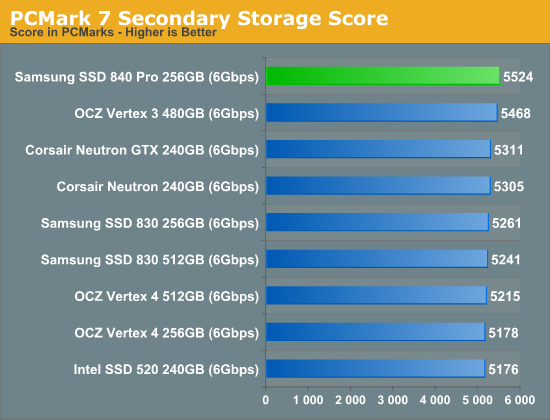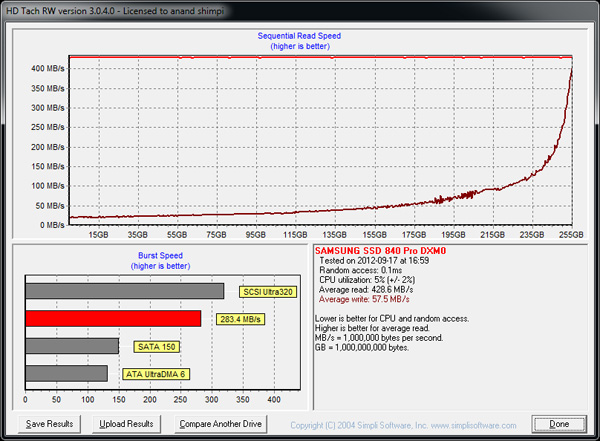Samsung SSD 840 Pro (256GB) Review
by Anand Lal Shimpi on September 24, 2012 7:00 AM EST- Posted in
- Storage
- SSDs
- Samsung
- Samsung SSD 840
PCMark 7
PCMark 7's secondary storage benchmark does little to show us differences between modern, high-performance SSDs as everything here scores within 5% of one another - but that's the point. For most mainstream client uses you'd be hard pressed to tell the difference between two good 6Gbps SSDs. Worry more about cost and reliability than outright performance if you're considering an SSD for a normal machine. Anything you see here will be much faster than a mechanical drive.

Performance Over Time & TRIM
Over time SSDs can get into a fairly fragmented state, with pages distributed randomly all over the LBA range. TRIM and the naturally sequential nature of much client IO can help clean this up by forcing blocks to be recycled and as a result become less fragmented. Leaving as much free space as possible on your drive helps keep performance high (20% is a good number to shoot for), but it's always good to see how bad things can get before the GC/TRIM routines have a chance to operate. As always I filled all user addressible LBAs with data, wrote enough random data to the drive to fill the spare area and then some, then ran a single HD Tach pass to visualize how slow things got:
The 840 Pro is really no different than the 830 when it comes to how low performance can get in the worst case scenario. Client users will want to keep some free space on the drive to avoid getting backed into this type of a performance corner. TRIM will obviously help and looks to be fully functional on the 840 Pro:












96 Comments
View All Comments
kensiko - Monday, September 24, 2012 - link
Interesting!Can Anand comment on that? Or verify it?
jb510 - Monday, September 24, 2012 - link
Same question. How do the Samsung provided numbers comparing the 830 to 840 on page 1:Active Power Use 0.24W 0.068W
Idle Power Use 0.14W 0.042W
Jive with the actual test numbers?
Guspaz - Monday, September 24, 2012 - link
I must be missing something, but on the first page, the rated power usage is:Active Power Use : 0.068W
Idle Power Use: 0.042W
While the actual measured use is 0.31W for idle and over 3W for active. That's about 50x higher, what's going on here?
btb - Monday, September 24, 2012 - link
Yeah, and no measurement of read power usage. Even though the typical user probably do an order of a magnitude more reads than writes. But thats a general anandtech testing problem, too much focus on the write specs instead of the more important read specs.ssj3gohan - Monday, September 24, 2012 - link
See my comment above here: Anandtech measures the power consumption wrongly. DIPM is not enabled, which causes ridiculously much higher power consumption.krumme - Monday, September 24, 2012 - link
The Anand hd bench was an excellent tool for comparisons, and one of the great tools Anand provided for us for delivering bm that reflected real world usage.What i derived from the first 2010 results was that the samsung disk was bad, but not so bad as it was portrayed by the reviewers and Anand. They were not worth their money, but they were slammed way to hard. At that time if we look at fx. strartup times, they were practically as fast as the fastest, so the criticism was ok, but a tad overblown.
At that time many producers was as Anand said, not focusing enough on random 4k, but i can say for sure, nothing but random 4k write was usable here at anandtech at that time too :)
sheh - Monday, September 24, 2012 - link
As usual, I'm curious about the data retention properties of drives, and how they change across a drive's lifespan as P/E cycles increase. It would be difficult to check directly, but perhaps the manufacturers can reveal the details? I also wonder if TLC will be disastrous in this regard.Kristian Vättö - Monday, September 24, 2012 - link
I asked about that in the Q&A session we had with Samsung engineers today but unsurprisingly, they couldn't tell us specific numbers. I hope to get my hands on 120GB 840 and 128GB 840 Pro to see what's the write endurance like, though that will take a while to test.FunBunny2 - Monday, September 24, 2012 - link
It looks like even the Pro has no standby cap? How can that be anything better than a toss away consumer drive?sheh - Monday, September 24, 2012 - link
They couldn't/wouldn't give numbers on P/E cycles or retention time?If you have a secret AnandTech stash of P/E exhausted drives (or could create one :), how about checksumming everything and testing every few months?